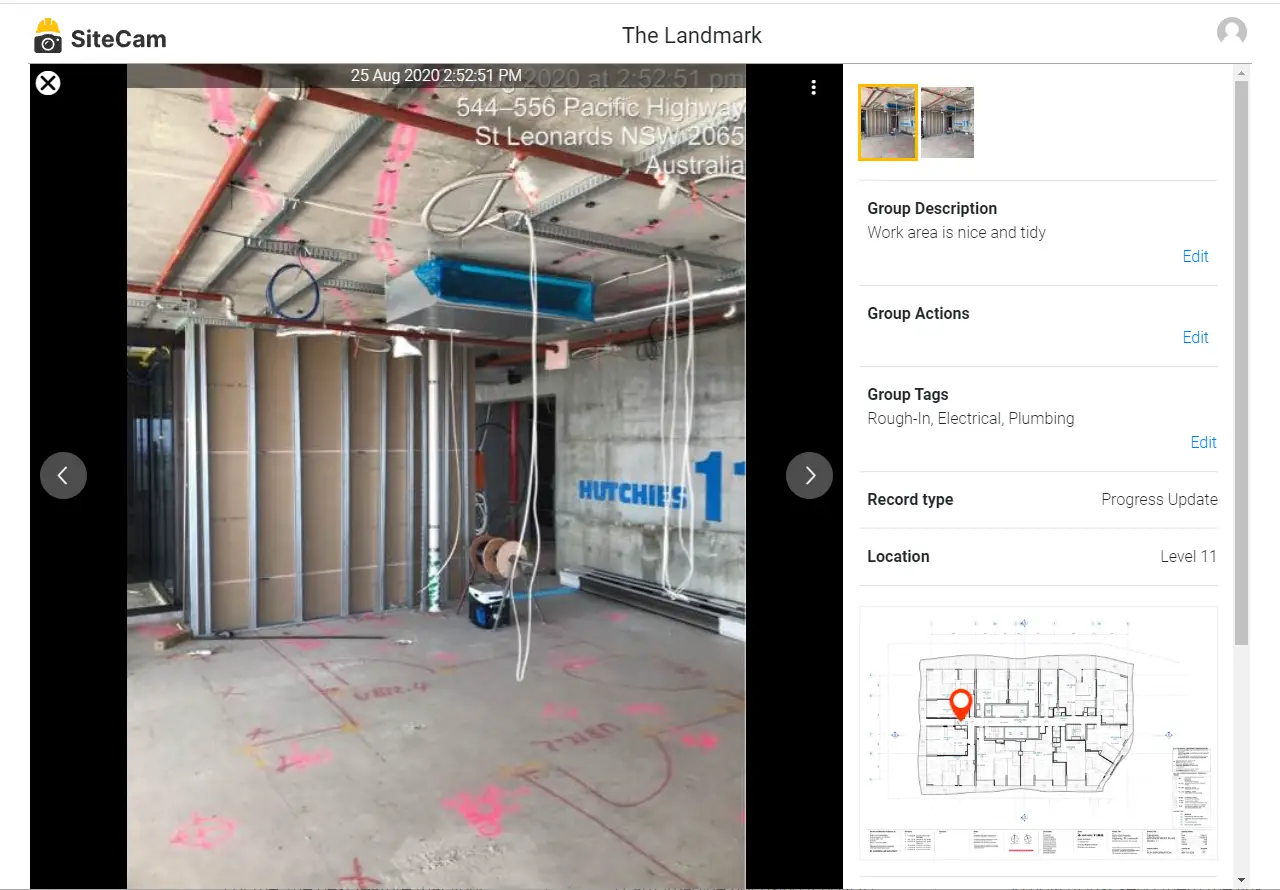Understanding Photo Metadata

Photo metadata is a set of data that is embedded within a photo file that provides additional information about the image. This can include details such as the date and time the photo was taken, the device used, camera settings, and GPS coordinates. In construction, metadata is really important as it may be used as evidence in disputes. It can also help with photo documentation and record keeping purposes. In this article, we will cover the basics of metadata, how to view them on your computer, and ways you can edit them too.
Table of Contents
Types of Photo Metadata
There are three main types of metadata that are stored in photo files: EXIF, IPTC, and XMP:
Exchangeable Image File Format (EXIF)
EXIF metadata, short for Exchangeable Image File Format, is like a digital fingerprint for your photos. When you take a picture with your camera or smartphone, it automatically creates and stores information about the device such as the make and model, the shutter speed, aperture, and ISO. EXIF also stores the date and time the photo was captured (timestamp). If your device has GPS support, it will also store the location where the picture was taken. EXIF is the most common form of metadata you will come across in photo files.
International Press Telecommunications Council (IPTC)
IPTC metadata was initially developed for news agencies to embed information about the photographer, copyright, caption, and keywords within images. It is now more commonly used by people and some software packages to store detailed information about an image, such as the title, description, keywords, and categories.
Extensible Metadata Platform (XMP)
XMP metadata, short for Extensible Metadata Platform, is a metadata format created by Adobe that can store a wide range of information, including EXIF and IPTC data, as well as custom metadata fields. XMP is extensible, allowing users to define and store custom metadata fields relevant to their needs. It is compatible with various file formats, including JPEG, TIFF, PDF, and even video files which makes it versatile.
How to view photo metadata on Windows 10 or 11
Using File Properties
On Windows, the file properties dialog shows some of the most common EXIF metadata as well as some IPTC fields, like title, subject, comments, and copyright. Follow the steps below to view the metadata on a Windows PC.
Step-by-Step:
- Browse to the photo in File Explorer.
- Right Click > Properties
- Click on the Details Tab
Unfortunately, Windows file properties won’t display all the metadata that may be embedded in the file. To view all the metadata stored in the photo, you will need to use dedicated metadata software such as ExifTool (free). Continue reading to learn how!
Editing Metadata using Windows Properties
You can edit some metadata directly using the Windows properties dialog but not everything. Simply click on an editable metadata in the Details tab to modify it.
For example, you can edit the date a photo was taken by clicking on the “Date taken” property. This will change the “DateTimeOriginal” EXIF metadata. However, Windows doesn’t provide a way to modify the time metadata using this method. We will learn how to do this using Exiftool.
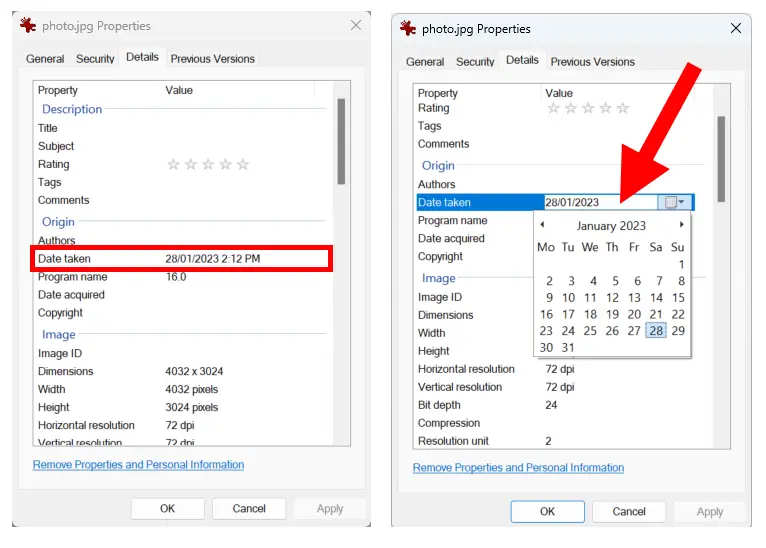
Using Exiftool
Exiftool is an excellent free software created by Phil Harvey that allows you to view and edit photo metadata. There are two ways you can use this software.
- If you just want to view the metadata, follow the Basic steps.
- If you want to view, edit and use more advanced features of Exiftool, skip to the Advanced section below.
Basic (View Only)
Step-by-Step:
- Download the latest Windows executable version of Exiftool from the official website.
- Unzip the executable file (exiftool(-k).exe) somewhere on your computer.
- Drag a photo file onto the executable file to view the metadata of that file.
Advanced (View and Edit)
Step-by-Step:
- Download the latest Windows executable version from the official website.
- Unzip the executable file (exiftool(-k).exe) somewhere on your computer.
- Rename the executable to “exiftool.exe” (ie. remove the (-k) from the original name.
- Move exiftool.exe to your Windows directory. This will allow you to run Exiftool via command line.
- Open Command Prompt (Press Windows Key + R and type “CMD” in the dialog box)
- In Command Prompt type “exiftool” followed by the command you want to run. Below are some useful commands.
Viewing Metadata in Exiftool
- Open Command Prompt
- Type “exiftool” followed by the photo file path:
exiftool <file path>For example, if the photo file path is “C:/Photo/photo.jpg”, enter the following in Command Prompt and press the Enter key.
exiftool "C:/Photos/photo.jpg"You will see all the metadata in the photo file appear on the Command Prompt window.
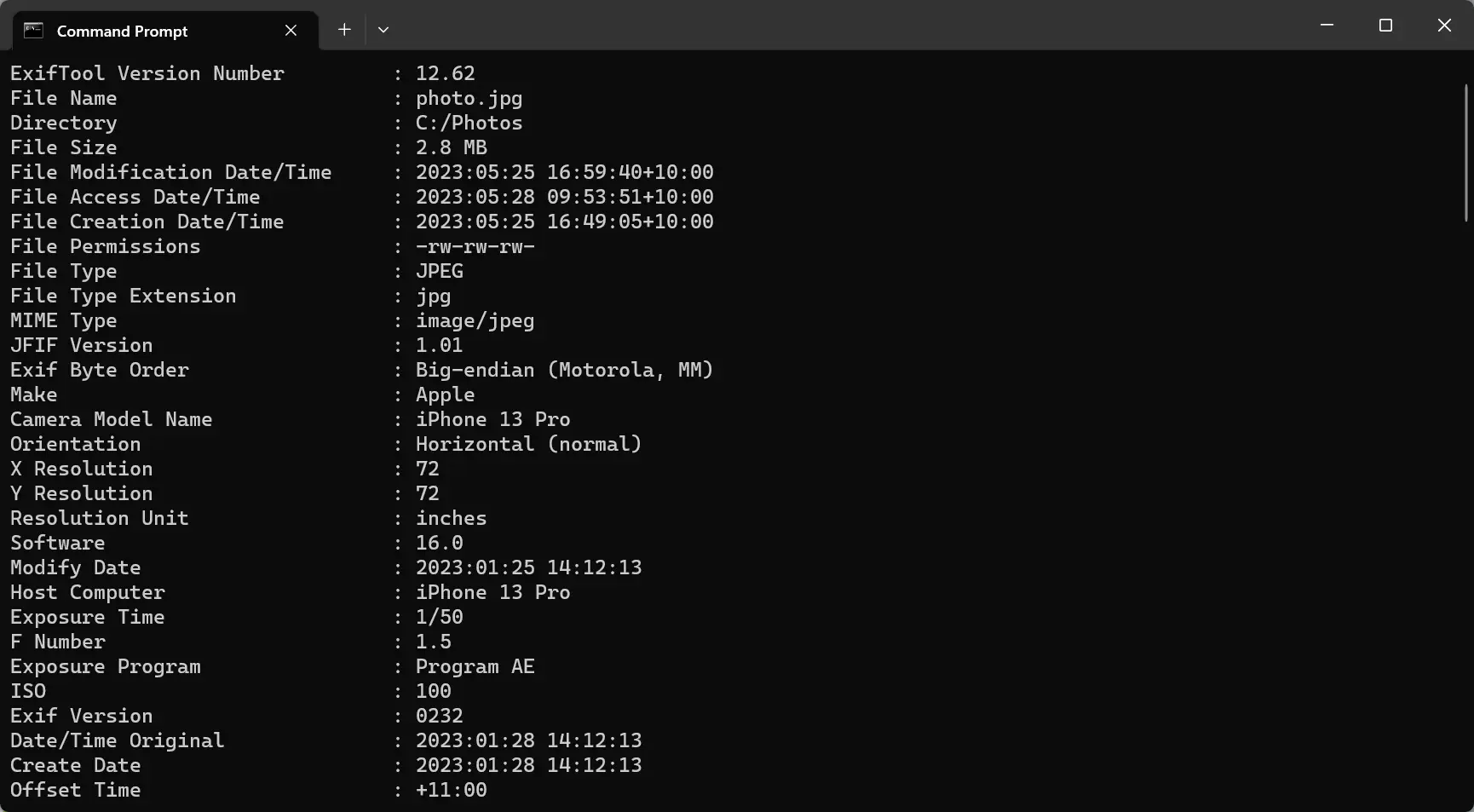
Editing the Timestamp using Exiftool
- Open Command Prompt
- Type the following command:
exiftool -DateTimeOriginal="YYYY:MM:DD HH:MM:SS" <file path>For example, if the photo file path is “C:/Photo/photo.jpg”, enter the following in Command Prompt and press the Enter key.
exiftool -DateTimeOriginal="2022:12:25 15:30:00" "C:/Photos/photo.jpg"You will see the DateTimeOriginal EXIF metadata get updated like below:
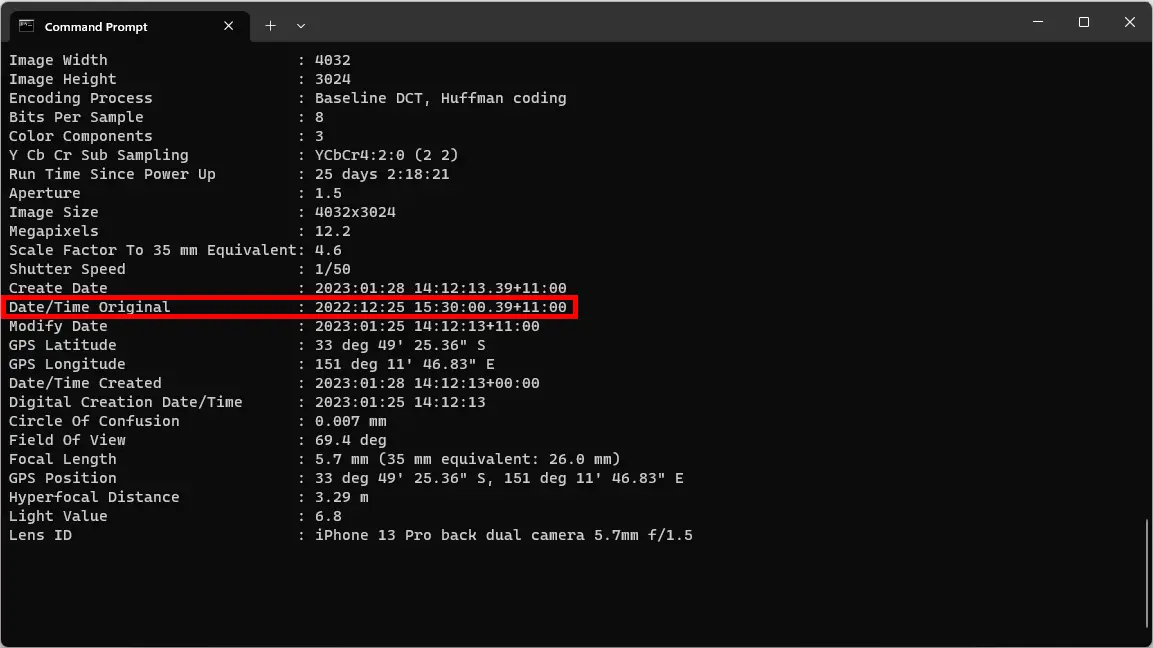
Editing the GPS Coordinates using Exiftool
To edit or set the GPS coordinates on a photo, you can use the following command:
exiftool -GPSLatitude=<latitude> -GPSLatitudeRef=<latitude ref> -GPSLongitude=<longitude>
-GPSLongitudeRef=<longitude ref> <file path>The latitude and longitude values should be provided in Decimal Degrees (DD) format. Positive values indicate North for latitude and East for longitude, while negative values indicate South for latitude and West for longitude.
For example, if you wanted to set the GPS metadata to (-25.345, 131.035) and your photo file path is “C:/Photos/photo.jpg”, enter the following in Command Prompt and press the Enter key.
exiftool -GPSLatitude=-25.345 -GPSLatitudeRef=S -GPSLongitude=131.035 -GPSLongitude=E "C:/Photos/photo.jpg"You will see the GPS Latitude, GPS Longitude and GPS Position metadata values get updated like below:
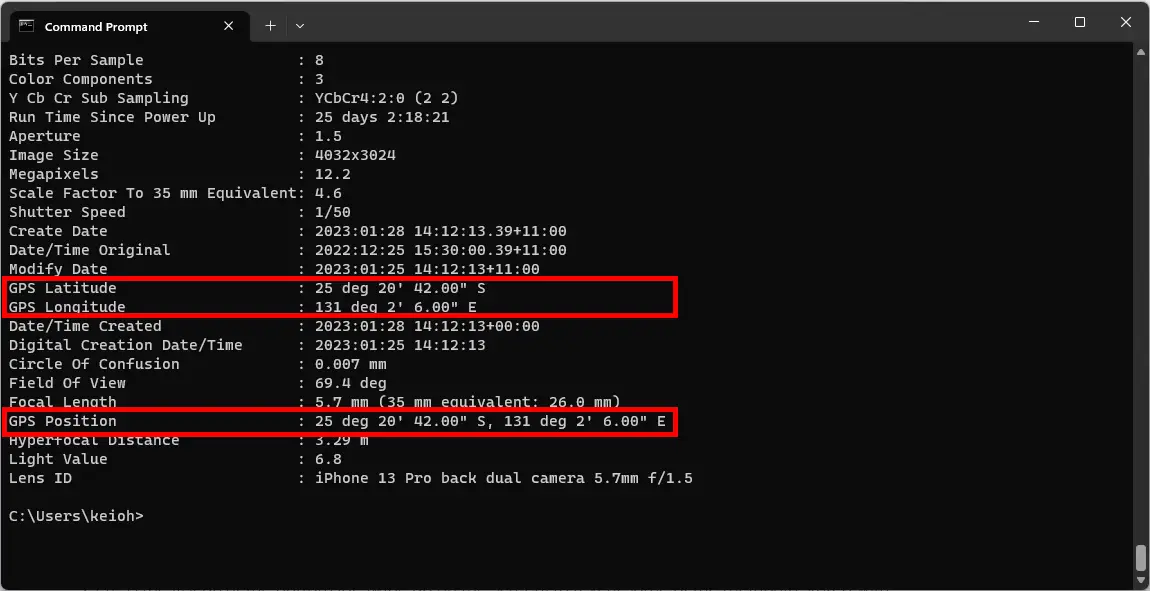
How to get GPS values using Google Maps in Decimal Degrees (DD) format
An easy way to get the GPS coordinates in DD format is to use Google Maps. Navigate to the location you want to get values for and simply right click on the spot to open a menu. The GPS values will be shown at the top of the menu and it will get copied to your clipboard if you click on it.
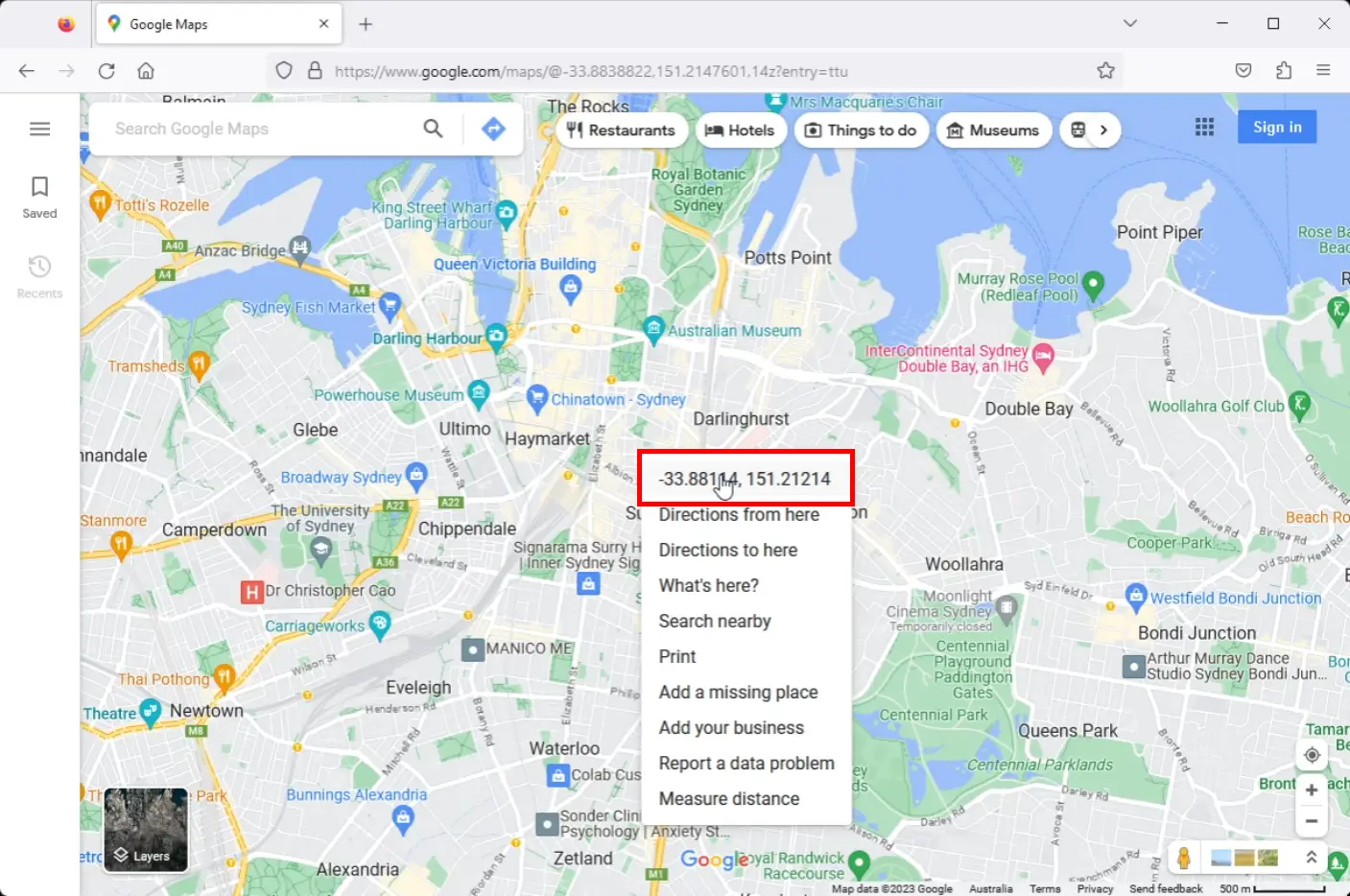
Editing Metadata on Multiple Photos using Exiftool
The great thing about Exiftool is that you can edit the metadata on multiple photos at once. You basically use the same command as editing a single file but you specify multiple file paths:
exiftool -DateTimeOriginal="YYYY:MM:DD HH:MM:SS" <file path 1> <file path 2> <file path 3>For example, changing the timestamp on multiple photos:
exiftool -DateTimeOriginal="2022:12:25 15:30:00" "C:/Photos/photo1.jpg" "C:/Photos/photo2.jpg" "C:/Photos/photo3.jpg"If you have a whole folder to edit, replace the file path with a folder path like below:
exiftool -DateTimeOriginal="2022:12:25 15:30:00" "C:/Photos"Detecting corrupt metadata in images using Exiftool
The following command is handy to check if an image file metadata is corrupt or has some other issues:
exiftool -validate -warning -error -a <file path>Example checking validity of a single image file:
exiftool -validate -warning -error -a "C:/Photos/photo1.jpg"Alternatively, you can check the validity of a whole folder:
exiftool -validate -warning -error -a "C:/Photos"What if my photos don’t have metadata?
If metadata is not present in a file, it can mean several things:
The metadata was stripped
The file may have originally had metadata, but it was removed at some point. This can be done intentionally for privacy reasons or it may have been removed unintentionally when the photo was edited or sent to you. Many chat platforms such as Whatsapp, Telegram and Facebook messenger strip sensitive metadata on files that are shared through their platform.
The file was created without metadata
Some devices and camera apps have settings that allow the user to control which metadata is saved with the photo. For example, GPS tagging can be disabled on some devices.
The metadata is hidden or encrypted
In some cases, metadata might be present but not readily visible, for example, if it’s stored in a non-standard format or if it’s encrypted. You can try opening the photo using a more advanced metadata tool such as ExifTool.
The file has been damaged
If a file has been corrupted or improperly modified, its metadata might have been lost even if it was originally present. You can try using some data recovery software designed to repair corrupted image files, however, their success can vary.
Can you restore lost metadata from a photo file?
Once metadata has been removed from a photo, it typically cannot be restored to the original photo file unless you have a backup of the original file or the original data. There are some software tools and services that claim to be able to recover metadata from photos, but these are typically limited in their capabilities. They often rely on finding “residual” metadata that was not completely removed when the main metadata was deleted. However, if the metadata has been thoroughly removed, these tools will likely not be able to recover it.
Try SiteCam for Free
Understanding what metadata is, and how to view them and edit them on your computer is a great skill to have. However, if you work with others in a team, it may be difficult to get everyone to take, organize and share site photos properly with the metadata intact. If you are looking for a simpler solution that can save you time and stay organized, try SiteCam for free and see how a dedicated site photo management app will streamline your site inspection process. Sign up here:
